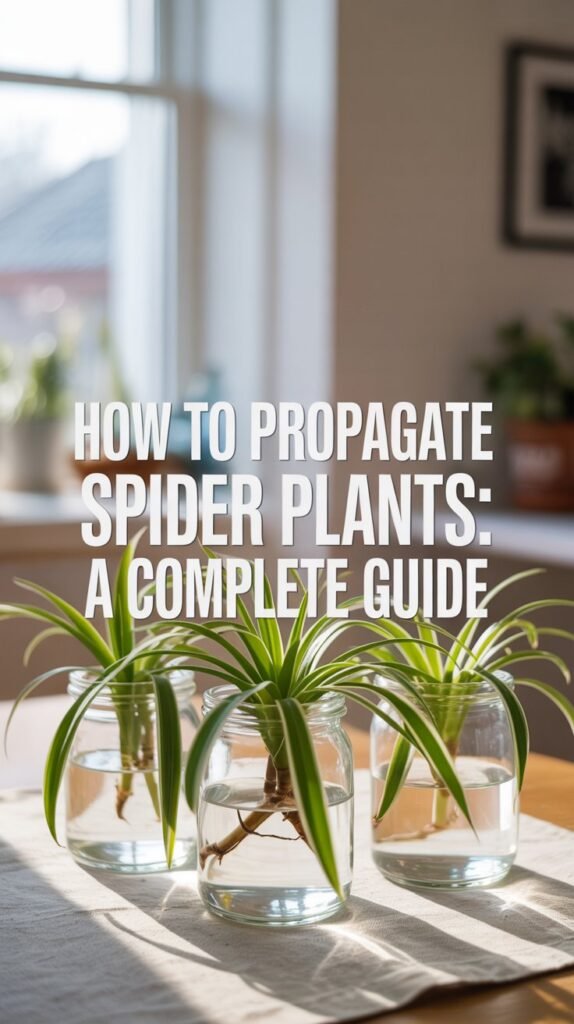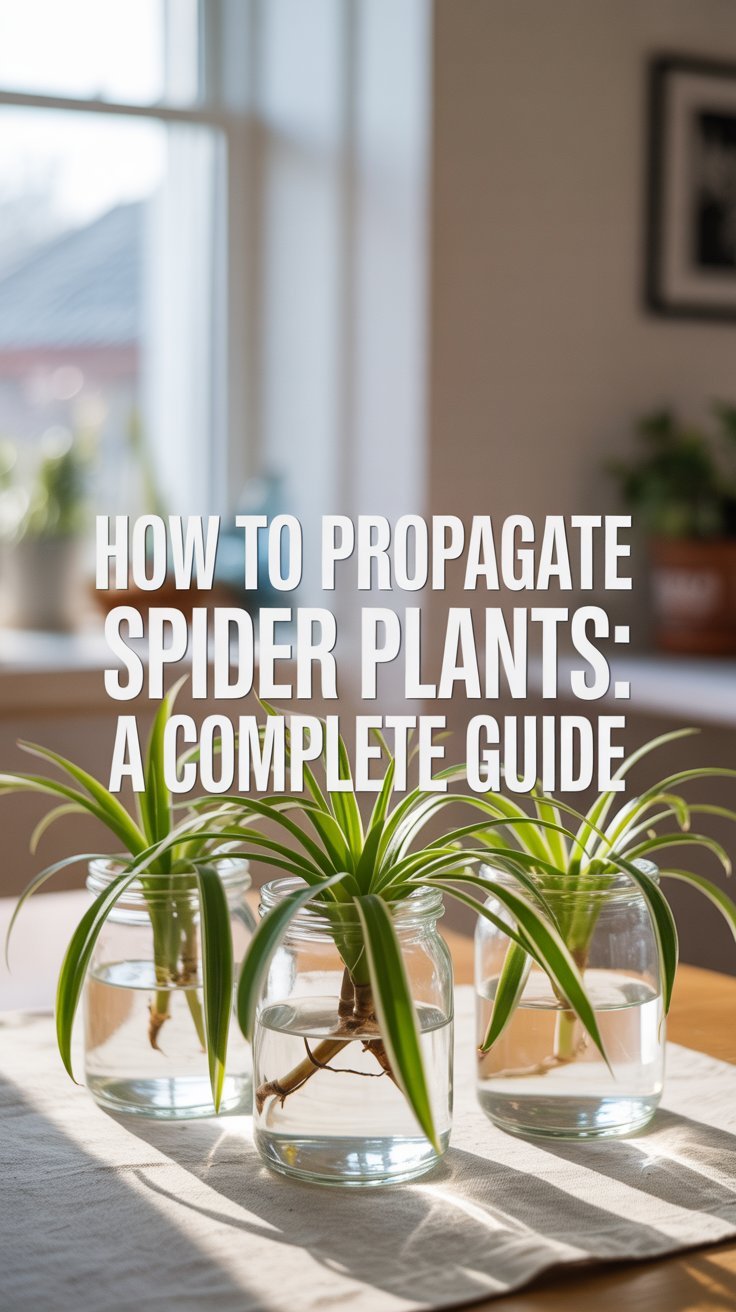Learn how to propagate spider plants with this easy guide! From babies to water and leaves, Ashley Scott shares step-by-step tips based on 10 years of gardening experience.

Hey there, plant lovers! If you’ve ever admired a spider plant’s long, arching leaves or its cute little offshoots, you’re not alone. Spider plants are a favorite in homes across the USA—and for good reason. They’re low-maintenance, air-purifying, and super easy to multiply. That’s where propagation comes in! In this article, I’ll walk you through how to propagate spider plants using different methods, sharing tips I’ve picked up over my 10 years of gardening.
Whether you want to grow your collection or gift a plant to a friend, propagating spider plants is a fun and rewarding process. I still remember the first time I propagated a spider plant—it was a baby from my mom’s giant plant, and I was hooked! Let’s dive into the details so you can get started too.
What is Propagation?
Propagation is just a fancy word for making new plants from one you already have. For spider plants, it’s usually about using those adorable “babies” (also called spiderettes) that dangle from the mother plant on long stems. These babies are like mini clones, ready to grow into full plants with a little help. It’s a budget-friendly way to fill your home with greenery or share the love with others.
Methods of Propagating Spider Plants
There’s more than one way to propagate a spider plant, and I’ll cover the most popular methods below. Whether you’re working with babies, trying water propagation, or even experimenting with leaves, I’ve got you covered.
1. Propagating from Babies (Spiderettes)
This is the easiest and most reliable method. Spider plants naturally produce babies, and with a few simple steps, you can turn them into new plants.
Step-by-Step Guide:
- Look for babies with tiny roots—little nubs at the base mean they’re ready.
- Snip the baby off the stem with scissors or gently twist it free.
- Grab a small pot and fill it with well-draining soil (I mix potting soil with a bit of perlite).
- Plant the baby so the roots are covered, then give it a light watering.
- Place it in bright, indirect light and keep the soil moist but not soaked.
- In 2-4 weeks, you’ll see it start to grow!
2. Propagating in Water
Want to watch roots grow before planting? How to propagate spider plants in water is a fun twist on the baby method.
Step-by-Step Guide:
- Cut a baby with small roots from the mother plant.
- Pop it into a glass of water, keeping the roots submerged and the leaves dry.
- Change the water every few days to keep it fresh.
- After 2-3 weeks, when the roots are a few inches long, move it to soil.
- Care for it like any potted spider plant—bright light and light watering.
I tried this once with a stubborn baby that wouldn’t root in soil. Watching those white roots sprout in water was so satisfying!
3. Propagating from Leaves
Curious about how to propagate spider plant from leaf? It’s trickier and less common, but it’s doable if you’re patient.
Step-by-Step Guide:
- Pick a healthy, full-grown leaf and cut it near the base, including a bit of stem.
- Stick it in water (roots-down) or plant it directly in moist soil.
- Keep it warm and bright, and wait—roots might take weeks or even months to show.
- If roots form, pot it up in soil and treat it like a regular plant.
Fair warning: this method doesn’t always work. I’ve had a few leaf cuttings fizzle out, but it’s worth a shot if you’re feeling experimental.
4. Propagating Without Babies
What if your plant isn’t making babies? How to propagate spider plant without babies is a common question. It’s tougher, but here are some options:
- Runners: Those long stems (runners) can sometimes root if pinned to soil while still attached to the mother plant. I’ve done this by laying a runner over a pot and securing it with a pebble—roots formed in a few weeks!
- Flowers: Spider plants rarely bloom indoors, but if yours does, the flowers might turn into seeds. Propagating from seeds is advanced and not practical for most of us.
If your plant’s not producing spiderettes, check its conditions—more light or a slight dry spell might encourage them.
Common Questions and Answers
Over the years, I’ve heard lots of questions about propagating spider plants. Here are quick answers to the big ones, perfect for voice search or featured snippets.
How Long Does It Take to Propagate Spider Plants?
- Babies in soil: 2-4 weeks for growth.
- In water: 2-3 weeks for roots, then a few more in soil.
- Leaves: Months, if it works at all.
Can You Propagate Spider Plants from Leaves?
Yes, but it’s harder and less reliable than using babies. Stick to spiderettes if you want quick success.
Do Spider Plants Need Soil to Propagate?
Not at first—you can start in water—but they’ll need soil eventually to grow strong and healthy.
My Personal Experience and Tips
I’ll never forget my first spider plant propagation. I snagged a baby from my mom’s overflowing plant, potted it up, and crossed my fingers. A month later, it was thriving, and I felt like a gardening pro! Since then, I’ve propagated dozens—some for me, some as gifts. It’s such a cool way to spread the plant love.
Here’s a tip from my 10 years of trial and error: patience is key. Babies might take a bit to root, and new plants need time to settle. Also, don’t overwater—soggy soil is a spider plant’s worst enemy. If your plant’s slow to produce babies, try a sunnier spot or a light dose of fertilizer. Stress can actually kickstart those spiderettes!
Conclusion
There you have it—everything you need to know about how to propagate spider plants! Whether you’re snipping babies, rooting them in water, or giving leaf cuttings a go, it’s a simple way to grow your green family. With a little care, you’ll have new plants to enjoy or share in no time. Ready to try it? Grab your spider plant and get propagating!
For more plant care ideas, check out my guides on Spider Plant Flowers or Plant Cutting Propagation Techniques over at USA Garden Hub.





One comment on “How To Propagate Spider Plants: A Complete Guide”